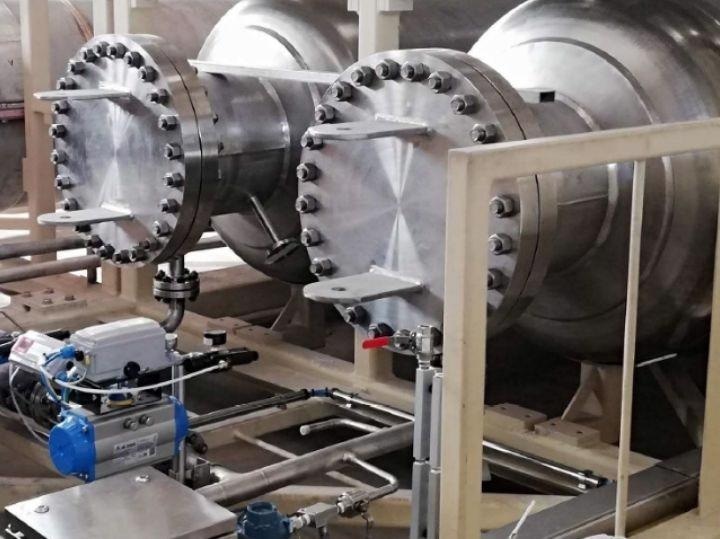An untouched, almost pure argon deposit that has been left since the formation of the Earth is set to help physicists gather better insight into the universe.
 The Urania Project facility in southwest Colorado will be located alongside an existing natural gas drilling site. The facility will house a processing plant that has been designed specifically for this project and constructed in Sardinia, Italy, then shipped to the Colorado location. Image Credit: University of Houston
The Urania Project facility in southwest Colorado will be located alongside an existing natural gas drilling site. The facility will house a processing plant that has been designed specifically for this project and constructed in Sardinia, Italy, then shipped to the Colorado location. Image Credit: University of Houston
Under the Urania Project, guided by Andrew Renshaw, associate professor of physics in the University of Houston’s College of Natural Sciences and Mathematics, the installation and commissioning of an industrial-scale structure in southwest Colorado will begin with the help of a $2.9 million National Science Foundation grant.
Simultaneously in Sardinia, Italy, with assistance from the Italian funding agency Istituto Nazionale Fisica Nucleare (INFN), scientists will design and build a dedicated processing plant that will be transported to Colorado.
Within the combined facility — the processing plant built in Italy and the outer structure constructed onsite by the Urania Project (titled as such after the Greek muse of astronomy) — the argon will be mined, purified and transported to Laboratorio Nazionale Gran Sasso (LNGS) in Italy. There, it will be employed in the quest for answers to a number of major puzzles the universe poses.
However, before the researchers can search upward among the stars, they first have to look deep inside the earth.
Simply put, they must see to the mining and processing of argon gas discovered in a southwest Colorado natural gas drilling location run by a Houston-based drilling and pipeline company, Kinder Morgan.
Our facility will exist as a side function to Kinder Morgan’s Doe Canyon facility, which is already pulling CO2 (carbon dioxide) from the Earth’s mantle as part of its natural gas mining. Contained within this CO2 stream coming from those deep underground Kinder Morgan wells is a small amount of low-radioactivity argon, which becomes a byproduct in their production of natural gas but is a tool that we can utilize.
Andrew Renshaw, Project Lead and Associate Professor of Physics, College of Natural Sciences and Mathematics, University of Houston
“This is interesting because the low-radioactivity argon can be a major asset to our research, as it is a very nice element to use inside a low-background particle detector,” Renshaw added.
Eventually, the argon is extracted from the CO2 at Kinder Morgan’s site, then transported in high-pressure cylinders specifically built for this project, to Sardinia, where it will be additionally processed, and then conveyed to LNGS for insertion into the underground detector, known as DarkSide‑20k.
“Once the argon is liquified, it can be used at the LNGS research site to detect particles according to how they interact with the liquid argon,” Renshaw said.
During those studies, the researchers hope to put together an indication of the universe’s dark matter and achieve the ability to identify neutrinos from astrophysical sources.
Argon (Ar) — which is odorless, colorless and tasteless — is recorded on the far-right side of the periodic table along with five other “noble gases” (suggesting they are inert, or virtually chemically unreactive). As one of the most prevalent elements on Earth, argon can be found nearly everywhere. Researchers can harvest it effortlessly from the atmosphere.
So why is this particular argon in Colorado so vital to the Urania project and the DarkSide‑20k experiment in Italy?
“Because it is almost 100% argon-40, having been protected deep underground since the formation of the earth,” Renshaw explained.
During the same span of time, the atmosphere’s argon has been constantly bombarded by cosmic rays, loading it with argon-39, which then decays via beta emission and can cloud the DarkSide‑20k particle detector’s signals. This means that the argon extracted from deep underground in Colorado will allow DarkSide‑20k to be filled with almost 100% pure argon-40, greatly reducing the overall background rate of the detector and allowing for many sensitivity studies to be done.
Andrew Renshaw, Project Lead and Associate Professor of Physics, College of Natural Sciences and Mathematics, University of Houston
What the scientists hope to expose with the DarkSide‑20k particle detector (projected to be in operation for 10 years, beginning in 2025), are indications of dark matter in the universe — what it is, why it exists, and how it acts. Specifically, they wish to shed light on one of the darkest obscurities of the cosmos.